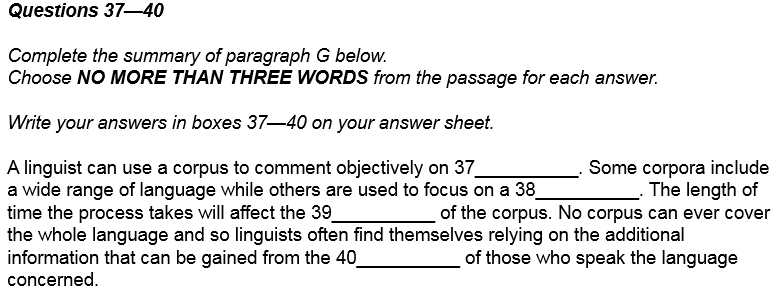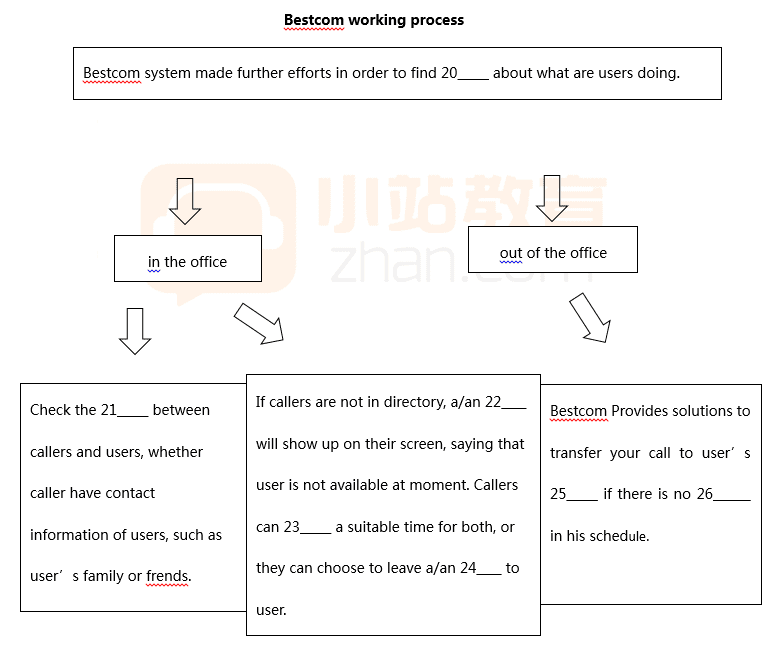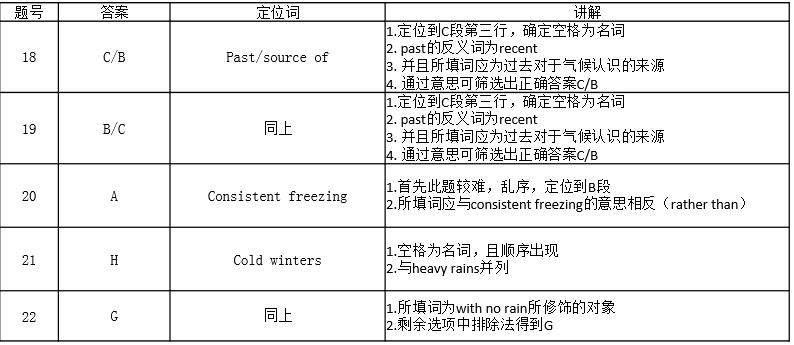托福阅读考试中有一种名为否定事实信息题的题型,这种题型的特点就是会在题干中假如一个EXCEPT或者NOT来让考生进行选项排除式的解题。今天小编给大家带来了托福阅读否定事实信息题3大考点实例讲解,希望可以帮助到大家,下面小编就和大家分享,来欣赏一下吧。
托福阅读否定事实信息题3大考点实例讲解
托福阅读否定事实信息题考点:对文章或段落主题抓取能力的考察
答题时注意看每个选项,尤其是当选项中出现了在该段落中没有的词句时,就可以考虑可能会有某个选项跟本段甚至整片文章的主题是相悖的。
请看下面例题:
Decades before this disaster,environmentalist had predicted just such an enormous oil spill in this areabecause of the treacherous nature of the waters due to the submerged reefs,icebergs, and violent storms there. They had urged that oil be transported tothe continental United States by land-based pipeline rather than by oil tankeror by undersea pipeline to reduce the potential damage to the environment posedby the threat of an oil spill.
Which point is NOT made by theenvironmentalist mentioned in paragraph 2?
A. That a huge oil spill in thewaters off Alaska was possible.
B. That the waters off the coastof Alaska were dangerous for ships.
C. That oil tanker should not beused to transport oil from Alaska.
D. That an undersea pipeline waspreferable to a land-based pipeline.
这道题题干中提到的environmentalist是整个该段的主语,故不能作为关键信息词。而发现A. C.中的Alaska,都在段落中没有提到。所以可以考虑某个答案与主题相悖。这类题目,也可以多关注段落中是否有表示转折的词汇,例如but, instead of, however, rather than. 所以,稍加阅读后,发现……land-based pipeline rather than by oil tanker or by underseapipeline…… 这句话当中出现rather than, 锁定D选项中同样的话语,刚好与原文观点相反,所以选择D.
托福阅读否定事实信息题考点:对最基本的细节信息理解的考察
这里可以用更简单的说法:从词中选。 所谓从词中选,就是可以在文章中找到几个名词,他们排列存在,共同构成某一事件的所有细节。这时候,出题者会提取出其中三个,并在文章别处或者自编一个跟本事件并无关系的名词(词组)。
请看下面的例子:
In1943, the federal government imposed rent controls to help solve the problem ofhousing shortages during wartime. The federal program ended after the war, butin some locations, including NY, controls continued. Under NY’s controls, alandlord generally cannot raise rents on APartments as long as the tenantscontinue to renew their leases. In places as Santa Monica, California, rentcontrols are more recent. They were spurred by inflation of the 1970’s, whichcombined with California’s rapid population growth, pushed housing prices, aswell as rents, to record levels.
Which of the following was NOT a reason forthe introduction of rent controls in Santa Monica, California?
A. Rapid population growth
B. Inflation
C. Economic conditions duringwartime
D. Record-high housing prices
在这道排除题中,由于四个选项提供的信息都是用名词词组,我们可以断定,段落中一定存在其中三个词组,而题干中又出现地名Santa Monica, California. 故可将此地名作为关键词,锁定答案所在句子,然后逐一排除。而……as Santa Monica, California, rent controlsare more recent. They were spurred by inflation of the 1970’s, which combinedwith California’s rapid population growth, pushed housing prices, ……. 这句话当中分别提到了A, B, D三个答案,所以答案为C.
托福阅读否定事实信息题考点:对事件发展程序理解的考察
这类排除题,也可以叫做------从句中选。即考题所提供的答案均为相对比较完整的句子,那么其中有三句话,一定是表达了整个事件发展比较关键的几个步骤,只有一句话与此步骤相悖。这类排除题通常比较耗费时间,考生需要准确判断其事件发展步骤,甚至要通读全段,才能找出正确选项。这里,我给大家提供一种在很大程度上节省时间的方法------点对点寻找。
请看下面的例子:
The sauce that is today called ketchup (orcatsup) in western cultures is a tomato-based sauce that is quite distinct fromthe eastern ancestors of this product. A sauce called ke-tiap was in use inChina at least as early as the seventeenth century but the Chinese version ofsauce was made of pickled fish, shellfish, and spices. The popularity of thisChinese sauce spread to Singapore and Malaysia where it was called kechap. The Indonesiasauce ketjab drives its name from the same sauce as Malaysian sauce but is madefrom very different ingredients. The Indonesian ketjab is made by cooking blacksoy beans, fermenting them, placing them in salt brine for at least a week,cooking the resulting solution further, and sweetening it heavily; this processresults in a dark, thick, and sweet variation of soy sauce.
It is NOT stated in paragraph 1 that
A. the Chinese sauce was inexistence in 17th century
B. the Malaysian sauce was similarto the Chinese sauce
C. the Chinese sauce was made fromseafood and spices
D. the Indonesian sauce wassimilar to the Chinese sauce
对于这道题,题干中没有任何指示性的词汇,我们无法判断是从事件的哪个阶段入手,那么就只能每个答案逐一排除。仔细阅读A选项,然后发现A选项中有17th century, 故可以将其作为关键线索,去文中寻找,……called ke-tiap was in use in China at least as early as theseventeenth century…… 文中的这句话表明A不能作为正确答案。那么继续看B, B选项中同时提到Malaysian 与Chinese. 则可以到文中去寻找两个国籍名词同时出现的句子,通过判断,…… this Chinese sauce spread to Singapore and Malaysia where it wascalled kechap. 这句话表明,B也不能作为正确答案。继续看C,C 选项当中有Chinese, 还有seafood andspices,于是锁定文中句子……the Chineseversion of sauce was made of pickled fish, shellfish, and spices……, 故C也不是正确选项。至此,我们可以直接选择D作为排除选项。
托福阅读素材之埃及罗塞塔石碑
A Rosetta Stone for a lost language
0:11
I'd like to begin with a thought experiment. Imagine that it's 4,000 years into the future. Civilization as we know it has ceased to exist -- no books, no electronic devices, no Facebook or Twitter. All knowledge of the English language and the English alphabet has been lost. Now imagine archeologistsdigging through the rubble of one of our cities. What might they find? Well perhaps some rectangular pieces of plastic with strange symbols on them. Perhaps some circular pieces of metal. Maybe some cylindrical containers with some symbols on them. And perhaps one archeologist becomes an instant celebrity when she discovers -- buried in the hills somewhere in North America -- massive versions of these same symbols. Now let's ask ourselves, what could such artifacts say about us to people 4,000 years into the future?
1:14
This is no hypothetical question. In fact, this is exactly the kind of question we're faced with when we try to understand the Indus Valley civilization, which existed 4,000 years ago. The Indus civilization was roughly contemporaneous with the much better known Egyptian and the Mesopotamian civilizations,but it was actually much larger than either of these two civilizations. It occupied the area of approximately one million square kilometers, covering what is now Pakistan, Northwestern India and parts of Afghanistan and Iran. Given that it was such a vast civilization, you might expect to find really powerful rulers, kings, and huge monuments glorifying these powerful kings. In fact, what archeologists have found is none of that. They've found small objects such as these.
1:59
Here's an example of one of these objects. Well obviously this is a replica. But who is this person? A king? A god? A priest? Or perhaps an ordinary person like you or me? We don't know. But the Indus people also left behind artifacts with writing on them. Well no, not pieces of plastic, but stone seals, copper tablets, pottery and, surprisingly, one large sign board, which was found buried near the gate of a city. Now we don't know if it says Hollywood, or even Bollywood for that matter. In fact, we don't even know what any of these objects say, and that's because the Indus script is undeciphered. We don't know what any of these symbols mean.
2:44
The symbols are most commonly found on seals. So you see up there one such object. It's the square object with the unicorn-like animal on it. Now that's a magnificent piece of art. So how big do you think that is? Perhaps that big? Or maybe that big? Well let me show you. Here's a replica of one such seal.It's only about one inch by one inch in size -- pretty tiny. So what were these used for? We know that these were used for stamping clay tags that were attached to bundles of goods that were sent from one place to the other. So you know those packing slips you get on your FedEx boxes? These were used to make those kinds of packing slips. You might wonder what these objects contain in terms of their text.Perhaps they're the name of the sender or some information about the goods that are being sent from one place to the other -- we don't know. We need to decipher the script to answer that question.
3:38
Deciphering the script is not just an intellectual puzzle; it's actually become a question that's become deeply intertwined with the politics and the cultural history of South Asia. In fact, the script has become a battleground of sorts between three different groups of people. First, there's a group of people who are very passionate in their belief that the Indus script does not represent a language at all. These people believe that the symbols are very similar to the kind of symbols you find on traffic signs or the emblems you find on shields. There's a second group of people who believe that the Indus script represents an Indo-European language. If you look at a map of India today, you'll see that most of the languages spoken in North India belong to the Indo-European language family. So some people believe that the Indus script represents an ancient Indo-European language such as Sanskrit.
4:28
There's a last group of people who believe that the Indus people were the ancestors of people living in South India today. These people believe that the Indus script represents an ancient form of the Dravidian language family, which is the language family spoken in much of South India today. And the proponents of this theory point to that small pocket of Dravidian-speaking people in the North, actually near Afghanistan, and they say that perhaps, sometime in the past, Dravidian languages were spoken all over India and that this suggests that the Indus civilization is perhaps also Dravidian.
5:03
Which of these hypotheses can be true? We don't know, but perhaps if you deciphered the script, you would be able to answer this question. But deciphering the script is a very challenging task. First, there's no Rosetta Stone. I don't mean the software; I mean an ancient artifact that contains in the same text both a known text and an unknown text. We don't have such an artifact for the Indus script.And furthermore, we don't even know what language they spoke. And to make matters even worse,most of the text that we have are extremely short. So as I showed you, they're usually found on these seals that are very, very tiny.
5:37
And so given these formidable obstacles, one might wonder and worry whether one will ever be able to decipher the Indus script. In the rest of my talk, I'd like to tell you about how I learned to stop worryingand love the challenge posed by the Indus script. I've always been fascinated by the Indus script ever since I read about it in a middle school textbook. And why was I fascinated? Well it's the last major undeciphered script in the ancient world. My career path led me to become a computational neuroscientist, so in my day job, I create computer models of the brain to try to understand how the brain makes predictions, how the brain makes decisions, how the brain learns and so on.
6:15
But in 2007, my path crossed again with the Indus script. That's when I was in India, and I had the wonderful opportunity to meet with some Indian scientists who were using computer models to try to analyze the script. And so it was then that I realized there was an opportunity for me to collaborate with these scientists, and so I jumped at that opportunity. And I'd like to describe some of the results that we have found. Or better yet, let's all collectively decipher. Are you ready?
6:41
The first thing that you need to do when you have an undeciphered script is try to figure out the direction of writing. Here are two texts that contain some symbols on them. Can you tell me if the direction of writing is right to left or left to right? I'll give you a couple of seconds. Okay. Right to left, how many? Okay. Okay. Left to right? Oh, it's almost 50/50. Okay. The answer is: if you look at the left-hand side of the two texts, you'll notice that there's a cramping of signs, and it seems like 4,000 years ago, when the scribe was writing from right to left, they ran out of space. And so they had to cram the sign. One of the signs is also below the text on the top. This suggests the direction of writing was probably from right to left, and so that's one of the first things we know, that directionality is a very key aspect of linguistic scripts. And the Indus script now has this particular property.
7:34
What other properties of language does the script show? Languages contain patterns. If I give you the letter Q and ask you to predict the next letter, what do you think that would be? Most of you said U, which is right. Now if I asked you to predict one more letter, what do you think that would be? Now there's several thoughts. There's E. It could be I. It could be A, but certainly not B, C or D, right? The Indus script also exhibits similar kinds of patterns. There's a lot of text that start with this diamond-shaped symbol. And this in turn tends to be followed by this quotation marks-like symbol. And this is very similar to a Q and U example. This symbol can in turn be followed by these fish-like symbols and some other signs, but never by these other signs at the bottom. And furthermore, there's some signsthat really prefer the end of texts, such as this jar-shaped sign, and this sign, in fact, happens to be the most frequently occurring sign in the script.
8:24
Given such patterns, here was our idea. The idea was to use a computer to learn these patterns, and so we gave the computer the existing texts. And the computer learned a statistical model of which symbols tend to occur together and which symbols tend to follow each other. Given the computer model, we can test the model by essentially quizzing it. So we could deliberately erase some symbols,and we can ask it to predict the missing symbols. Here are some examples. You may regard this as perhaps the most ancient game of Wheel of Fortune.
9:04
What we found was that the computer was successful in 75 percent of the cases in predicting the correct symbol. In the rest of the cases, typically the second best guess or third best guess was the right answer. There's also practical use for this particular procedure. There's a lot of these texts that are damaged. Here's an example of one such text. And we can use the computer model now to try to complete this text and make a best guess prediction. Here's an example of a symbol that was predicted. And this could be really useful as we try to decipher the script by generating more data that we can analyze.
9:36
Now here's one other thing you can do with the computer model. So imagine a monkey sitting at a keyboard. I think you might get a random jumble of letters that looks like this. Such a random jumble of letters is said to have a very high entropy. This is a physics and information theory term. But just imagine it's a really random jumble of letters. How many of you have ever spilled coffee on a keyboard?You might have encountered the stuck-key problem -- so basically the same symbol being repeated over and over again. This kind of a sequence is said to have a very low entropy because there's no variation at all. Language, on the other hand, has an intermediate level of entropy; it's neither too rigid,nor is it too random. What about the Indus script? Here's a graph that plots the entropies of a whole bunch of sequences. At the very top you find the uniformly random sequence, which is a random jumble of letters -- and interestingly, we also find the DNA sequence from the human genome and instrumental music. And both of these are very, very flexible, which is why you find them in the very high range. At the lower end of the scale, you find a rigid sequence, a sequence of all A's, and you also find a computer program, in this case in the language Fortran, which obeys really strict rules. Linguistic scripts occupy the middle range.
10:49
Now what about the Indus script? We found that the Indus script actually falls within the range of the linguistic scripts. When this result was first published, it was highly controversial. There were people who raised a hue and cry, and these people were the ones who believed that the Indus script does not represent language. I even started to get some hate mail. My students said that I should really seriously consider getting some protection. Who'd have thought that deciphering could be a dangerous profession? What does this result really show? It shows that the Indus script shares an important property of language. So, as the old saying goes, if it looks like a linguistic script and it acts like a linguistic script, then perhaps we may have a linguistic script on our hands. What other evidence is there that the script could actually encode language?
11:38
Well linguistic scripts can actually encode multiple languages. So for example, here's the same sentence written in English and the same sentence written in Dutch using the same letters of the alphabet. If you don't know Dutch and you only know English and I give you some words in Dutch,you'll tell me that these words contain some very unusual patterns. Some things are not right, and you'll say these words are probably not English words. The same thing happens in the case of the Indus script. The computer found several texts -- two of them are shown here -- that have very unusual patterns. So for example the first text: there's a doubling of this jar-shaped sign. This sign is the most frequently-occurring sign in the Indus script, and it's only in this text that it occurs as a doubling pair.
12:23
Why is that the case? We went back and looked at where these particular texts were found, and it turns out that they were found very, very far away from the Indus Valley. They were found in present day Iraq and Iran. And why were they found there? What I haven't told you is that the Indus people were very, very enterprising. They used to trade with people pretty far away from where they lived, and so in this case, they were traveling by sea all the way to Mesopotamia, present-day Iraq. And what seems to have happened here is that the Indus traders, the merchants, were using this script to write a foreign language. It's just like our English and Dutch example. And that would explain why we have these strange patterns that are very different from the kinds of patterns you see in the text that are found within the Indus Valley. This suggests that the same script, the Indus script, could be used to write different languages. The results we have so far seem to point to the conclusion that the Indus script probably does represent language.
13:19
If it does represent language, then how do we read the symbols? That's our next big challenge. So you'll notice that many of the symbols look like pictures of humans, of insects, of fishes, of birds. Most ancient scripts use the rebus principle, which is, using pictures to represent words. So as an example, here's a word. Can you write it using pictures? I'll give you a couple seconds. Got it? Okay. Great.Here's my solution. You could use the picture of a bee followed by a picture of a leaf -- and that's "belief," right. There could be other solutions. In the case of the Indus script, the problem is the reverse.You have to figure out the sounds of each of these pictures such that the entire sequence makes sense. So this is just like a crossword puzzle, except that this is the mother of all crossword puzzlesbecause the stakes are so high if you solve it.
14:17
My colleagues, Iravatham Mahadevan and Asko Parpola, have been making some headway on this particular problem. And I'd like to give you a quick example of Parpola's work. Here's a really short text.It contains seven vertical strokes followed by this fish-like sign. And I want to mention that these seals were used for stamping clay tags that were attached to bundles of goods, so it's quite likely that these tags, at least some of them, contain names of merchants. And it turns out that in India there's a long tradition of names being based on horoscopes and star constellations present at the time of birth. In Dravidian languages, the word for fish is "meen" which happens to sound just like the word for star.And so seven stars would stand for "elu meen," which is the Dravidian word for the Big Dipper star constellation. Similarly, there's another sequence of six stars, and that translates to "aru meen," which is the old Dravidian name for the star constellation Pleiades. And finally, there's other combinations,such as this fish sign with something that looks like a roof on top of it. And that could be translated into "mey meen," which is the old Dravidian name for the planet Saturn. So that was pretty exciting. It looks like we're getting somewhere.
15:29
But does this prove that these seals contain Dravidian names based on planets and star constellations?Well not yet. So we have no way of validating these particular readings, but if more and more of these readings start making sense, and if longer and longer sequences appear to be correct, then we know that we are on the right track. Today, we can write a word such as TED in Egyptian hieroglyphics and in cuneiform script, because both of these were deciphered in the 19th century. The decipherment of these two scripts enabled these civilizations to speak to us again directly. The Mayans started speaking to us in the 20th century, but the Indus civilization remains silent.
16:14
Why should we care? The Indus civilization does not belong to just the South Indians or the North Indians or the Pakistanis; it belongs to all of us. These are our ancestors -- yours and mine. They were silenced by an unfortunate accident of history. If we decipher the script, we would enable them to speak to us again. What would they tell us? What would we find out about them? About us? I can't wait to find out.
16:45
Thank you.
16:47
(Applause)
托福阅读否定事实信息题3大考点实例讲解
上一篇:托福考试遭遇阅读加试心得建议分享
下一篇:托福阅读省时技巧






